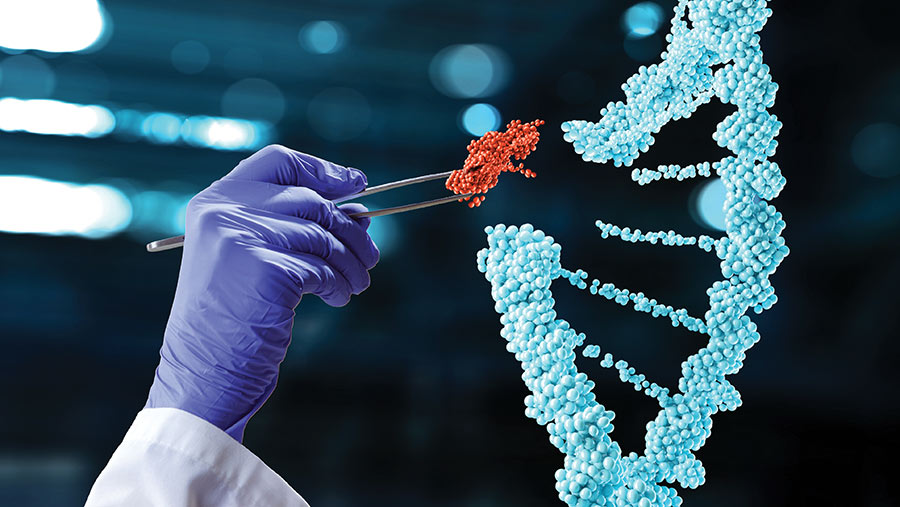Debate: Gene editing the pros and cons for farming
 © Adobe Stock
© Adobe Stock Current EU legislation means that new breeding techniques, of which gene editing is a primary example, are treated the same as all other form of genetic modification.
This makes is extremely difficult to bring new products, such as gene-edited seeds, to market and has stifled the development and use of such technologies within western Europe.
See also: Time to give the green light to gene editing
But recent comments by Defra secretary George Eustice suggest the government is keen to see gene editing playing a part in post-Brexit agriculture.
Such moves will be welcomed by many in the scientific and agricultural communities, but environmental campaigners and consumer groups are still wary.
What do we mean by genetic modification and gene editing?
In simplistic terms, genetic modification involves taking a gene from a different organism and inserting it into another organism to deliver a desired change, while gene editing involves tweaking the DNA in the same organism to change its expression.
We invited two stakeholders to share their views on gene editing in an exchange of letters:
The participants
 Kierra Box, Friends of the Earth
Kierra Box, Friends of the Earth
Kierra Box currently leads on trade and Brexit at Friends of the Earth, including advocating for a strong new environmental watchdog, having worked for four years as a campaigner on food, behaviour change and trade issues.
Having read history and English at Oxford, she also has 15 years’ experience working on a range of policy and campaign issues across the NGO and charity sector. She is a board member of campaign group GM Freeze.
 Tina Barsby, Niab
Tina Barsby, Niab
Tina Barsby is director and chief executive of Niab. A plant geneticist with significant experience in the agricultural crop sector, she has led and managed multifaceted research and development programmes in North America, the UK and mainland Europe.
She has a degree in agricultural botany from the University of Wales and a PhD from the University of Nottingham. Prior to joining Niab in 2006, she spent 17 years with Nickerson UK, now part of the LG Group.
Kiera:
Dear Tina
Shall we start with some common ground? I hope we can agree that gene editing “is” genetic modification.
I could point to legal judgements that back this up, but it is also common sense. Furthermore, GM isn’t currently banned across the UK, though it is tightly regulated – and should stay that way, in all its forms.
Interfering with complicated, interdependent systems can lead to unintended consequences. For example, the release of non-native game birds into the UK has been linked to a decline in curlew numbers, as the abundance of game birds led to an explosion in predator populations.
Our understanding of these ecosystems is still limited, and we continue to learn more about our impacts and the consequences of our actions.
DNA is like a complex micro-ecosystem – our most brilliant scientists are only now scratching the surface. Altering genes can have unintended consequences both within an organism and in relation to the wider ecosystem.
So when we mess with the genetic material of plants and animals, there are many reasons to be cautious.
The evidence so far doesn’t look great – in the case of Buri the bull, gene editing not only led to unplanned genetic changes (in the shape of antibiotic resistance), but this unintended consequence wasn’t even spotted by the US research company until Food and Drug Administration testing took place.
We are far from mastering this technology, and without ongoing regulation the consequences could be unpredictable and irreversible.
It is therefore sensible to implement particularly strong rules around technologies with no history of safe use, or insufficient data to demonstrate possible harms.
Genetic modification of all kinds fits this bill. So surely maintaining a strong, effective and transparent system of regulation is in everyone’s best interests?
Tina:
Dear Kierra
Sorry, but I cannot accept your assertion that gene editing is the same as genetic modification, nor do regulators in virtually all countries outside the EU.
Modifying genes by inducing variation (or messing with their genetic material as you describe it), has been part of conventional plant breeding for decades.
It’s just that, over time, our ability to create genetic variation in more targeted ways, reducing the need for lengthy back-crossing to remove unwanted characteristics, has improved in step with our understanding of genetic function.
I do agree that the products of plant breeding should continue to be subject to rigorous and transparent regulation.
The current statutory system has been in place for more than 50 years, providing the foundation not only to assess the quality and performance of new plant varieties, but also to support the outcomes society expects from agriculture, for example reduced input use and climate resilience.
I view scientific innovation in terms of the solutions it offers.
With ever more mouths to feed, the challenges of food security, climate change, biodiversity conservation and pressure on finite natural resources will not be solved by turning our backs on progress.
I note your observations about interfering with ecosystems, but of course farming itself is not, and never has been “natural”.
None of the crops that make up our farmed landscape are native to this country – not even the grass.
All are “alien species”, which have been imported from around the globe and adapted to our growing conditions and markets by the most amazing scientific and agricultural interventions.
At the same time, farmers spend much of their time trying to sustain their crops in the face of “natural” intrusion, in the form of weeds, diseases, insects and other pests.
Scientific innovations, such as gene editing, increasingly offer better ways to protect harvests while minimising impacts on unfarmed habitats and environments.
Kiera:
Dear Tina
I too believe we should be looking for solutions to the climate and ecological crisis we face. But genetic modification, in all its forms, is a distraction.
Tinkering with the DNA of crops and livestock won’t feed us more sustainably, because genetics aren’t the problem – deforestation, monocultures and a farming system built around the overuse of pesticides, fertilisers, hormones and antibiotics are.
Messing with genomes won’t protect a growing population from hunger, because we already grow more than enough food, then allow waste, poverty and access to markets to stop it reaching those who need it.
I don’t think I need to offer farmers alternative solutions – they understand these issues first hand, and many have already identified practical ways to farm more efficiently and sustainably.
From reducing inputs through integrated pest management techniques, to utilising cover cropping to support soils, or cutting food loss by investing in storage and transport infrastructure, these holistic, farmer-led innovations are more reliable, cheaper and safer than genetic modification.
It’s great to hear that you agree that gene editing should be subject to rigorous and transparent regulation. But, as you say, the current regulatory system is more than five decades old.
I have to wonder how a process developed to assess the efficacy of seeds created through sexual reproduction will cope with checking the entire genome for the unplanned DNA changes that are common with gene-editing techniques.
The real challenge facing farmers is the declining health of the ecosystems and climate our food production relies on.
This isn’t a debate about whether they can meet this challenge through technological, scientific or natural solutions – it is a question of how farmers can be most effectively and safely helped to produce food in ways that support, rather than harm, the environment.
Farmers are part of the solution to the climate and nature crisis – gene editing most certainly is not.
Tina:
Dear Kierra
Your assertion that we already have plenty of food is simply not borne out by the facts. For example, a 10-year study published in Nature (2018) led by conservation scientists at the University of Cambridge made clear that, even if steps are taken to limit growth in demand – reducing food waste, improving distribution and encouraging better diets – the rate of global population growth and demographic change means that, by themselves, these measures will not be enough.
While you and I may be comfortably fed, I believe we have a moral responsibility to use scientific innovation not only to increase agricultural productivity here, but also to help producers in less advantaged parts of the world.
If we do not improve the productivity and sustainability of our own farming systems, we will simply end up exporting issues elsewhere.
The fact that our variety approval system remains robust and effective after 50 years is a testament to its evolution in response to changing market, agronomic, environmental and technological developments.
Much of the success of modern plant breeding is due to laboratory-based techniques used to create new sources of genetic variation – for example cell fusion, embryo rescue, doubled haploidy, somaclonal variation, chemical and radiation-based mutagenesis.
These techniques are all accepted within organic farming standards – indeed a celebrated example is the barley variety Golden Promise, which was created by bombarding seeds with gamma rays to induce random mutations.
Gene-editing produces mutations, but not at random. Seed is the absolute foundation of sustainable agriculture. No amount of cover cropping, IPM, precision farming or data science can alter the basic genetic potential of what goes in the ground.
Genetic innovation in all its forms offers potential solutions to many of the problems you identify with our farming systems – especially when it comes to reliance on chemicals.
Genetic innovation could be used to deliver our clearly shared objectives for more sustainable farming.
